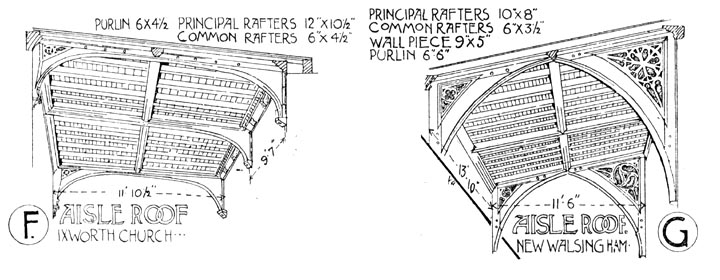
Aisle Roofs. Drawn by Banister Fletcher for A History of Architecture on the Comparative Method (5th ed), plate 112 (p. 285). Scanned image and text by George P. Landow (2007) [You may use this image without prior permission for any scholarly or educational purpose as long as you (1) credit the photographer and (2) link your document to this URL in a web document or cite the Victorian Web in a print one.]
Aisle Roofs in the early period were merely a continuation of the rafters of the nave. At North Walsham, Norfolk (a tie-beam roof), the tie-beam of the aisle is carried through the wall, forming a corbel for the wall-piece of the nave roof, thus binding the whole together. Aisle roofs were usually simple, intermediate trusses being introduced to strengthen the purlins. When they were gabled they were usually of low pitch, and the hammer-beam was rarely introduced for these. New Walsmingham Church (G) and Ixworth Church (F) are good types of aisle roofs. [pp. 293-94; illus. p. 292]
Open Timber Roofs of the Middle Ages
References
Fletcher, Banister, and Banister F. Fletcher. A History of Architecture on the Comparative Method for the Student, Craftsman, and Amateur. 5th ed. London: B. T. Batsford, 1905.
Last modified 1 September 2007